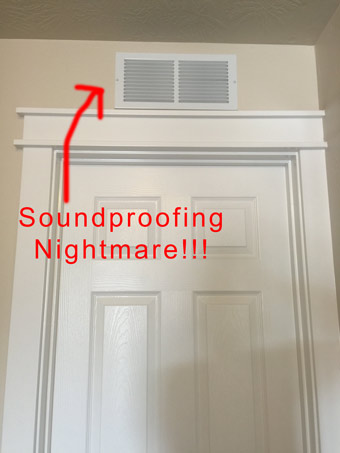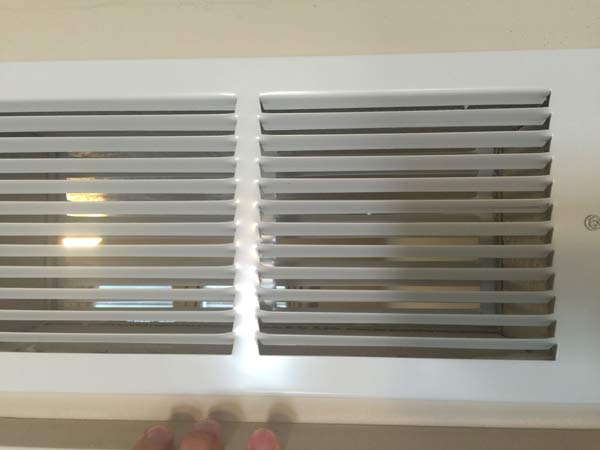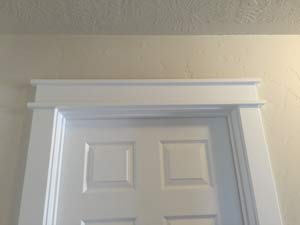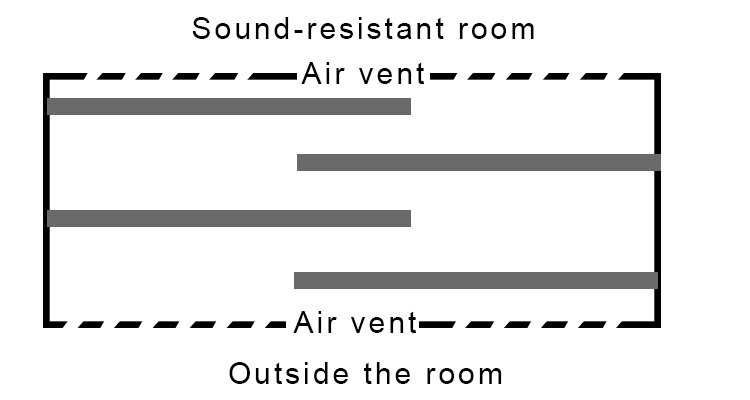
I built my home with special sound-proofing for my home office. I put in sound board, insulation, two solid-core doors, acoustic foam, and thick carpet. But there was one problem.
All of it did practically nothing because I had a completely open vent above the door which let sound pass through easily.
There are basically two ways to approach this soundproofing problem: (1) block the vent entirely, or (2) create a sound maze.

Blocking the Vent Method

The most soundproof approach is to remove the vent and drywall over the hole, but that’s a lot of work and cost that could have a much simpler solution. Instead, you could simply take the vents off, spray the area with gap filler (link to Amazon) so it entirely seals the area, and then put the vents on so that it looks normal again.
There is a huge problem with this approach. It’s that the room will likely get very hot during the summer. The air flow vent is there for a reason. It allows air to pass through the top of the doorway so that the room can be efficiently heated and cooled.
I made this mistake in my home office. I drywalled off the vent and the room has been difficult to keep cool. It hasn’t been horrible, but a little uncomfortable. In my next home office (we’re planning to move soon), I plan on testing out method #2.

Sound Maze Method
This method takes a little more work, but it will result in a room that is quiet but easily heated and cooled.
The way this works is that you make a miniature maze inside the vent space using pieces of thin wood with acoustic foam taped to the wood scraps. This way, the sound has to zig-zag around several times before entering the room, which will significantly deaden most sounds.
Materials needed to create an air duct sound maze
- Small amount of acoustic cotton or foam. I’d use this foam available on Amazon.
- A small amount of 1/4″ plywood
- A saw
- Small screws
- Glue
The down side to this method is that it isn’t as effective at blocking noise as simply drywalling off the duct or blocking the duct. However, it should dramatically cut the amount of sound compared to leaving the vent open.
I have not yet personally tried this method, but I’ve heard good things from those who have tested it.

Hi Jm,
Came across your blog which is interesting and helpful. I will use some tips from it. However, I wonder have you any other tips for me. My issue is not blocking outside noise or acoustics. I work as a psychotherapist and need to ensure that what is said in the room does not escape the from the room (as much as possible). In particular, through a door. Is the answer the same as excluding external noise or not?
Thanks & Regards,
Paddy
I know that this question was asked last year but this will hopefully reach you .
Your issue is a little different . While this idea would help to diffuse some of the noise, it really doesn’t make it sound proof. You will probably need a combination of solutions to take care of this problem.
Along with the idea from this article you will need to work on masking the sound that is coming from the room . A white noise machine should make the sound coming from the office much more difficult to hear and will make it hard to make out individual words. It works by making a low pitched static sound that sounds like background noise. When the level is right people won’t even recognize that they are hearing the white noise.
Tamarack Perfect Balance In-Door Return Air Pathway – basically it’s the same door vent you have, but comes with a sound/ light baffle
I have a larger grill opening above the door and have the same situation where I need the any vocal communication to stay within the room. Will a combination of an interior baffle/maze along with sound absorbing panels hung across the exterior grill (approx. 3-6″ away from grill) be effective in containing the voices?
I have a return directly infront of my HVAC fan abover the staircase to our 2nd floor. Everytime the machine turns on it sounds like sn airplane is landing. The vent is literally right in front of thd fan and no space to put additional ducts to dampen the sound. Any suggestion?
another way to keep some flow of air from 1 room to another and reduce sound is to put the grill on the ceiling and link it into the other room, using coated fibre board build a duct and create a maze to reduce sound but let air pass.
I don’t understand these vents, I have never seen them until moving to Idaho; we didn’t have them in California or Nevada, and my husband didn’t have them growing up in Alaska. We never ran into issues with keeping rooms warm or cool, I don’t understand why they put them in the houses here.